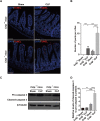Cathelicidin preserves intestinal barrier function in polymicrobial sepsis
- PMID: 32041659
- PMCID: PMC7011568
- DOI: 10.1186/s13054-020-2754-5
Cathelicidin preserves intestinal barrier function in polymicrobial sepsis
Abstract
Objectives: The intestinal epithelium compartmentalizes the sterile bloodstream and the commensal bacteria in the gut. Accumulating evidence suggests that this barrier is impaired in sepsis, aggravating systemic inflammation. Previous studies reported that cathelicidin is differentially expressed in various tissues in sepsis. However, its role in sepsis-induced intestinal barrier dysfunction has not been investigated.
Design: To examine the role of cathelicidin in polymicrobial sepsis, cathelicidin wild-(Cnlp+/+) and knockout (Cnlp-/-) mice underwent cecal-ligation and puncture (CLP) followed by the assessment of septic mortality and morbidity as well as histological, biochemical, immunological, and transcriptomic analyses in the ileal tissues. We also evaluated the prophylactic and therapeutic efficacies of vitamin D3 (an inducer of endogenous cathelicidin) in the CLP-induced murine polymicrobial sepsis model.
Results: The ileal expression of cathelicidin was increased by three-fold after CLP, peaking at 4 h. Knockout of Cnlp significantly increased 7-day mortality and was associated with a higher murine sepsis score. Alcian-blue staining revealed a reduced number of mucin-positive goblet cells, accompanied by reduced mucin expression. Increased number of apoptotic cells and cleavage of caspase-3 were observed. Cnlp deletion increased intestinal permeability to 4kD fluorescein-labeled dextran and reduced the expression of tight junction proteins claudin-1 and occludin. Notably, circulating bacterial DNA load increased more than two-fold. Transcriptome analysis revealed upregulation of cytokine/inflammatory pathway. Depletion of Cnlp induced more M1 macrophages and neutrophils compared with the wild-type mice after CLP. Mice pre-treated with cholecalciferol (an inactive form of vitamin D3) or treated with 1alpha, 25-dihydroxyvitamin D3 (an active form of VD3) had decreased 7-day mortality and significantly less severe symptoms. Intriguingly, the administration of cholecalciferol after CLP led to worsened 7-day mortality and the associated symptoms.
Conclusions: Endogenous cathelicidin promotes intestinal barrier integrity accompanied by modulating the infiltration of neutrophils and macrophages in polymicrobial sepsis. Our data suggested that 1alpha, 25-dihydroxyvitamin D3 but not cholecalciferol is a potential therapeutic agent for treating sepsis.
Keywords: Antimicrobial peptide; Bacterial translocation; LL-37; Sepsis.
Conflict of interest statement
The authors declare that they have no competing interests.
Figures










Similar articles
-
Effects of Different Routes and Forms of Vitamin D Administration on Mesenteric Lymph Node CD4+ T Cell Polarization and Intestinal Injury in Obese Mice Complicated with Polymicrobial Sepsis.Nutrients. 2022 Aug 29;14(17):3557. doi: 10.3390/nu14173557. Nutrients. 2022. PMID: 36079813 Free PMC article.
-
Fecal Microbiota Transplantation and Hydrocortisone Ameliorate Intestinal Barrier Dysfunction and Improve Survival in a Rat Model of Cecal Ligation and Puncture-Induced Sepsis.Shock. 2021 May 1;55(5):666-675. doi: 10.1097/SHK.0000000000001566. Shock. 2021. PMID: 32496421
-
Therapeutic Potential of Cathelicidin Peptide LL-37, an Antimicrobial Agent, in a Murine Sepsis Model.Int J Mol Sci. 2020 Aug 19;21(17):5973. doi: 10.3390/ijms21175973. Int J Mol Sci. 2020. PMID: 32825174 Free PMC article. Review.
-
Cathelicidin-deficient mice exhibit increased survival and upregulation of key inflammatory response genes following cecal ligation and puncture.J Mol Med (Berl). 2017 Sep;95(9):995-1003. doi: 10.1007/s00109-017-1555-z. Epub 2017 Jun 16. J Mol Med (Berl). 2017. PMID: 28623379
-
The roles of vitamin D and cathelicidin in type 1 diabetes susceptibility.Endocr Connect. 2021 Jan;10(1):R1-R12. doi: 10.1530/EC-20-0484. Endocr Connect. 2021. PMID: 33263562 Free PMC article. Review.
Cited by
-
CBP22, a Novel Bacteriocin Isolated from Clostridium butyricum ZJU-F1, Protects against LPS-Induced Intestinal Injury through Maintaining the Tight Junction Complex.Mediators Inflamm. 2021 Jun 1;2021:8032125. doi: 10.1155/2021/8032125. eCollection 2021. Mediators Inflamm. 2021. PMID: 34158805 Free PMC article.
-
A Dual-Response DNA Origami Platform for Imaging and Treatment of Sepsis-Associated Acute Kidney Injury.Adv Sci (Weinh). 2025 Apr;12(16):e2416330. doi: 10.1002/advs.202416330. Epub 2025 Feb 28. Adv Sci (Weinh). 2025. PMID: 40019357 Free PMC article.
-
Effects of Different Routes and Forms of Vitamin D Administration on Mesenteric Lymph Node CD4+ T Cell Polarization and Intestinal Injury in Obese Mice Complicated with Polymicrobial Sepsis.Nutrients. 2022 Aug 29;14(17):3557. doi: 10.3390/nu14173557. Nutrients. 2022. PMID: 36079813 Free PMC article.
-
A Focus on Intra-Abdominal Sepsis with Biomarkers: A Literature Review.Eurasian J Med. 2022 Dec;54(Suppl1):66-70. doi: 10.5152/eurasianjmed.2022.22296. Eurasian J Med. 2022. PMID: 36655448 Free PMC article.
-
The Role of Autophagy in Inflammatory Bowel Disease.Front Physiol. 2021 Feb 3;12:621132. doi: 10.3389/fphys.2021.621132. eCollection 2021. Front Physiol. 2021. PMID: 33633585 Free PMC article. Review.
References
-
- Wu Wan, Jiang Rong-lin, Wang Ling-cong, Lei Shu, Xing Xi, Zhi Yi-hui, Wu Jian-nong, Wu Yan-chun, Zhu Mei-fei, Huang Li-quan. Effect of Shenfu injection on intestinal mucosal barrier in a rat model of sepsis. The American Journal of Emergency Medicine. 2015;33(9):1237–1243. doi: 10.1016/j.ajem.2015.01.056. - DOI - PubMed
-
- DOIG CHRISTOPHER J., SUTHERLAND LLOYD R., DEAN SANDHAM J., FICK GORDON H., VERHOEF MARJA, MEDDINGS JON B. Increased Intestinal Permeability Is Associated with the Development of Multiple Organ Dysfunction Syndrome in Critically Ill ICU Patients. American Journal of Respiratory and Critical Care Medicine. 1998;158(2):444–451. doi: 10.1164/ajrccm.158.2.9710092. - DOI - PubMed
Publication types
MeSH terms
Substances
Grants and funding
LinkOut - more resources
Full Text Sources
Medical
Molecular Biology Databases
Research Materials
Miscellaneous

